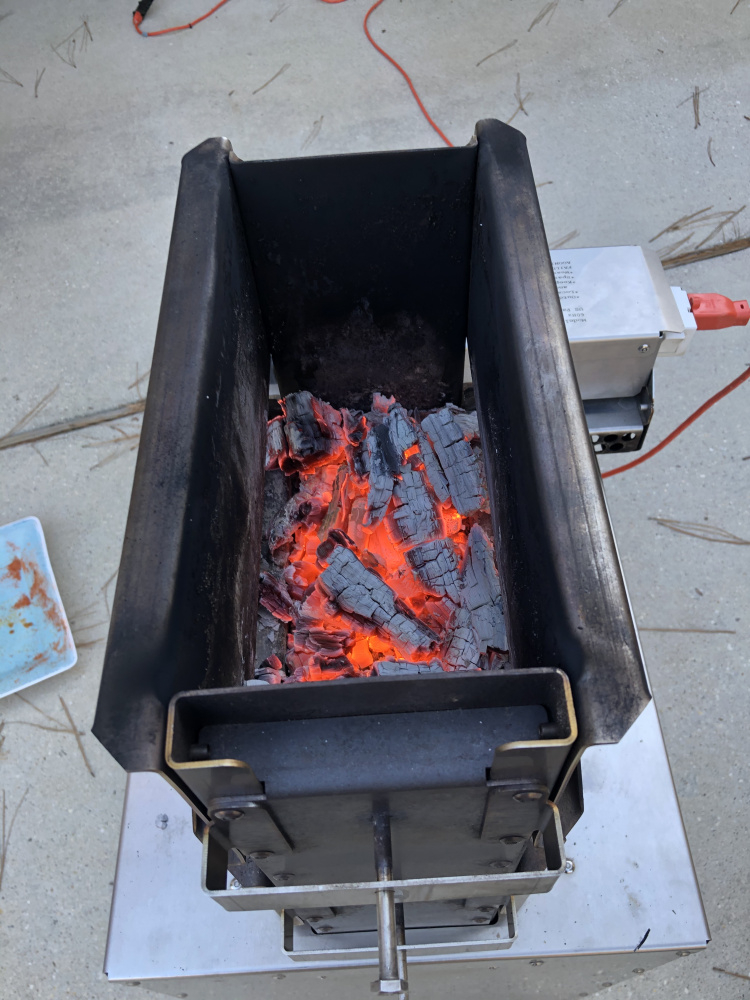Welcome to the EGGhead Forum - a great place to visit and packed with tips and EGGspert advice! You can also join the conversation and get more information and amazing kamado recipes by following Big Green Egg to Experience our World of Flavor™ at:
Want to see how the EGG is made? Click to Watch
Facebook | Twitter | Instagram | Pinterest | Youtube | Vimeo
Share your photos by tagging us and using the hashtag #BigGreenEgg.
Share your photos by tagging us and using the hashtag #BigGreenEgg.
Want to see how the EGG is made? Click to Watch
OT KBQ Learning Curve Is Steeper Than I Thought

Money_Hillbilly
Posts: 449
This is supposed to be easy right? A small thermostatically controlled stick burner that you only need to add a wood split every 30-45 minutes. Just build a campfire they say. Well not so fast. Hit and miss on my first 2 experimental cooks on the KBQ. First of all it is lots of fun to cook on, much more interactive than the egg however, there are many variables that I have discovered. My first cook was St Louis ribs that came out cooked perfectly but tasted like they came off a pellet smoker. No smoke. My second cook 2 pork butts came out the same way despite making a change of opening the top poppet for more smoke. After some research I have discovered my operation of the unit may be the problem. Looking for input from the other owners here.. My observations are as follows:
Poor wood quality and wrong wood. I tried to use up a number of pieces of pecan and cherry that I had in my garage. Both woods have poor coaling properties and were far too dry to create a good smoke profile. My research uncovered that pellets run about 5% moisture while good smoking wood ranges between 16-25%. Helps explain the mild pellet smoke profile and lack of smoke with my extremely dry wood. KBQ recommends hickory, oak and mesquite.
Since these woods didn’t make coals I ran for hours on end with open holes in the grate allowing the fans to draft lots of fresh air into the cabinet along that the smoke.
Poor wood quality and wrong wood. I tried to use up a number of pieces of pecan and cherry that I had in my garage. Both woods have poor coaling properties and were far too dry to create a good smoke profile. My research uncovered that pellets run about 5% moisture while good smoking wood ranges between 16-25%. Helps explain the mild pellet smoke profile and lack of smoke with my extremely dry wood. KBQ recommends hickory, oak and mesquite.
Since these woods didn’t make coals I ran for hours on end with open holes in the grate allowing the fans to draft lots of fresh air into the cabinet along that the smoke.
The poppet valves can be utilized to control smoke profile. I need to learn how to use them to control the smoke profile. KBQ uses the term dirty smoke when referring to the top valve. This made me apprehensive to run with it open.
So today I am off to source some local hickory, cherry and oak with a 20-30% moisture level. Brisket this week. I will get to the top of this mountain. I know one change at a time, but I do get impatient.
Pictures below:







Pictures below:







Southeast Louisiana
3 Larges, Rockin W Smokers Gravity Fed Unit, KBQ, Shirley Fabrication 24 x 36, Teppanyaki Stainless Griddle
3 Larges, Rockin W Smokers Gravity Fed Unit, KBQ, Shirley Fabrication 24 x 36, Teppanyaki Stainless Griddle
Comments
-
You nailed it. You need wood with more moisture that lays down a nice bed of coals. I found the guy who sells all the bbq joints in town and buy wood from him. One side of the yard is 24 month seasoned for firewood. The other side is 6-12 month for bbq. Find that guy if you can. Makes a huge difference.Keepin' It Weird in The ATX FBTX
-
-
@The Cen-Tex Smoker @Money_Hillbilly I'm a slow learner, but yeah - the moisture content as well as wood species makes a difference. I find I choose wood from my shed according to what I'm doing. I have oak and mesquite. Both of these are also in stages of relatively green to very dry. I think of the wood alsmost as an ingredient. I'll use drier wood for some things like poultry. Sometimes I'll mix woods of different moisture content. I may be fooling myslef but it's fun and makes me think about the cook.Coleman, Texas
Large BGE & Mini Max for the wok. A few old camp Dutch ovens and a wood fired oven. LSG 24” cabinet offset smoker. There are a few paella pans and a Patagonia cross in the barn. A curing chamber for bacterial transformation of meats...
"Bourbon slushies. Sure you can cook on the BGE without them, but why would you?"
YukonRon -
Thanks for posting this. I haven't done my first cook on my KBQ yet as it's a Christmas gift, but this is good to know.
XXL BGE, Karebecue, Klose BYC, Chargiller Akorn Kamado, Weber Smokey Mountain, Grand Turbo gasser, Weber Smoky Joe, and the wheelbarrow that my grandfather used to cook steaks from his cattle
San Antonio, TX
-
Cherry is a good wood for coaling. Pecan is not as good but works fine.I use mostly maple, oak, hickory, cherry, and pecan. Would use more apple but that has become a lot more difficult for me to get at a reasonable price in the last couple of years - would be a lot easier for me to get if everyone else would quit barbecuing.
 In case you haven't already seen this give it a read:As has already been mentioned leaning towards the greener/wetter wood is better than older/bone dry wood.Don't know how often you plan on using your KBQ but you may not want to get too much wood at a time.“Reality is that which, when you stop believing in it, doesn't go away.” ― Philip K. Diçk
In case you haven't already seen this give it a read:As has already been mentioned leaning towards the greener/wetter wood is better than older/bone dry wood.Don't know how often you plan on using your KBQ but you may not want to get too much wood at a time.“Reality is that which, when you stop believing in it, doesn't go away.” ― Philip K. Diçk -
You have a nice smoke ring on your cooks. Just a silly question though for you - Are you pulling the poppets out to allow the smoke to go into the cooking chamber? I thought that you needed to push them in to allow the smoke in and figured it out later that this was the exact opposite of what I was supposed to do.
I got post oak for my cooks. I build the coal bed initially with lump charcoal.
You will get the KBQ figured out soon. I love them smoke flavor that it puts in the food.Northern Colorado Egghead since 2012.
XL BGE and a KBQ.
-
My first KBQ cook was like yours, a friend gave me some hickory splits that had been in a shed for "a couple of years". No bueno! As you said, a learning curve but worth it...
1 LBGE, 1 SBGE, 1 KBQ and a 26" Blackstone near Blackstone, Virginia
Categories
- All Categories
- 183.4K EggHead Forum
- 15.8K Forum List
- 459 EGGtoberfest
- 1.9K Forum Feedback
- 10.4K Off Topic
- 2.2K EGG Table Forum
- 1 Rules & Disclaimer
- 9K Cookbook
- 12 Valentines Day
- 91 Holiday Recipes
- 224 Appetizers
- 520 Baking
- 2.5K Beef
- 88 Desserts
- 162 Lamb
- 2.4K Pork
- 1.5K Poultry
- 30 Salads and Dressings
- 320 Sauces, Rubs, Marinades
- 547 Seafood
- 174 Sides
- 121 Soups, Stews, Chilis
- 35 Vegetarian
- 100 Vegetables
- 315 Health
- 293 Weight Loss Forum






